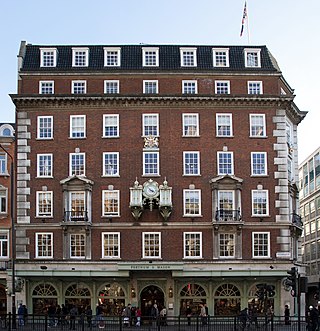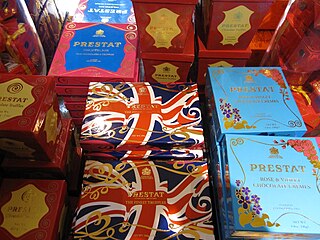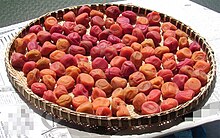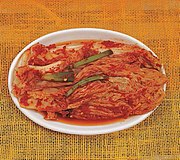
French cuisine is the cooking traditions and practices from France. In the 14th century, Guillaume Tirel, a court chef known as "Taillevent", wrote Le Viandier, one of the earliest recipe collections of medieval France. In the 17th century, chefs François Pierre La Varenne and Marie-Antoine Carême spearheaded movements that shifted French cooking away from its foreign influences and developed France's own indigenous style.

New England cuisine is an American cuisine which originated in the New England region of the United States, and traces its roots to traditional English cuisine and Native American cuisine of the Abenaki, Narragansett, Niantic, Wabanaki, Wampanoag, and other native peoples. It also includes influences from Irish, French-Canadian, Italian, and Portuguese cuisine, among others. It is characterized by extensive use of potatoes, beans, dairy products and seafood, resulting from its historical reliance on its seaports and fishing industry. Corn, the major crop historically grown by Native American tribes in New England, continues to be grown in all New England states, primarily as sweet corn although flint corn is grown as well. It is traditionally used in hasty puddings, cornbreads and corn chowders.

Foie gras ; French:[fwaɡʁɑ], ) is a specialty food product made of the liver of a duck or goose. According to French law, foie gras is defined as the liver of a duck or goose fattened by gavage.

Fortnum & Mason plc is an upmarket department store in London, England. The main store is located at 181 Piccadilly in the St James's area of London, where it was established in 1707 by William Fortnum and Hugh Mason. There are additional stores at The Royal Exchange, St Pancras railway station and Heathrow Airport in Greater London, at K11 Musea in Hong Kong, as well as various stockists worldwide. Fortnum & Mason is privately owned by Wittington Investments Limited.

Roasting coffee transforms the chemical and physical properties of green coffee beans into roasted coffee products. The roasting process is what produces the characteristic flavor of coffee by causing the green coffee beans to change in taste. Unroasted beans contain similar if not higher levels of acids, protein, sugars, and caffeine as those that have been roasted, but lack the taste of roasted coffee beans due to the Maillard and other chemical reactions that occur during roasting.

Farm Sanctuary is an American animal protection organization, founded in 1986 as an advocate for farmed animals. It was America's first shelter for farmed animals. It promotes laws and policies that support animal welfare, animal protection, and veganism through rescue, education, and advocacy. Farm Sanctuary houses over 800 cows, chickens, ducks, geese, turkeys, pigs, sheep, and goats at a 300+ acre animal sanctuary in Watkins Glen, New York and more than 100 animals at its location in Acton, California, near Los Angeles.

Chocolate is a food product made from roasted and ground cocoa pods mixed with fat and powdered sugar to produce a solid confectionery. There are several types of chocolate, classified primarily according to the proportion of cocoa and fat content used in a particular formulation.
Joseph Schmidt Confections was a San Francisco-based chocolatier, which created gourmet confections with imported Belgian chocolate. The line of confections included truffles of various sizes, slicks, and mosaics. Joseph Schmidt confections ceased operations in 2009.

Mostarda is a northern Italian condiment made of candied fruit and a mustard-flavoured syrup. Commercially the essential oil of mustard is employed, which has the advantage of transparency; in home cooking, mustard powder heated in white wine may be used.
Dan's Chocolates is a Burlington, Vermont chocolate maker.

The production of foie gras involves the controversial force-feeding of birds with more food than they would eat in the wild, and more than they would voluntarily eat domestically. The feed, usually corn boiled with fat, deposits large amounts of fat in the liver, thereby producing the fatty consistency sought by some gastronomes.

The Gourmet Ghetto is a colloquial name for the business district of the North Berkeley neighborhood in the city of Berkeley, California, known as the birthplace of California cuisine. Other developments that can be traced to this neighborhood include specialty coffee, the farm-to-table and local food movements, the rise to popularity in the U.S. of chocolate truffles and baguettes, the popularization of the premium restaurant designed around an open kitchen, and the California pizza made with local produce. After coalescing in the mid-1970s as a culinary destination, the neighborhood received its "Gourmet Ghetto" nickname in the late 1970s from comedian Darryl Henriques. Early, founding influences were Peet's Coffee, Chez Panisse and the Cheese Board Collective. Alice Medrich began her chain of Cocolat chocolate stores there.

Belgian chocolate is chocolate produced in Belgium. A major industry since the 19th century, today it forms an important part of the nation's economy and culture.
Third-wave coffee is a movement in coffee marketing emphasizing high quality. Beans are typically sourced from individual farms and are roasted more lightly to bring out their distinctive flavors. Though the term was coined in 1999, the approach originated in the 1970s, with roasters such as the Coffee Connection.

Prestat Ltd is one of London's oldest chocolate shops. It has been awarded two Royal Warrants: from Her Late Majesty The Queen and Her Late Majesty Queen Elizabeth The Queen Mother.

D’Artagnan (D'Artagnan, Inc., also known as D'Artagnan Foods) is a food seller and manufacturer of beef, pork, lamb, veal, pâtés, sausages, smoked and cured charcuterie, all-natural and organic poultry, game, free-range meat, foie gras, wild mushrooms, and truffles.
The chocolate industry in the Philippines developed after the introduction of the cocoa tree to Philippine agriculture. The growing of cacao or cocoa boasts a long history stretching from the colonial times. Originating from Mesoamerican forests, cacao was first introduced by the Spanish colonizers four centuries ago. Since then the Philippine cocoa industry has been the primary producer of cocoa beans in Southeast Asia. There are many areas of production of cacao in the Philippines, owing to soil and climate. The chocolate industry is currently on a small to medium scale.

Andrea Jourdan is a Canadian chef, ghost writer and a culinary author with over 100 published cookbooks.

Gabriel Kreuther is a two-Michelin-star restaurant in Manhattan named after its chef and owner, Gabriel Kreuther. It specializes in modern Alsatian food with other French, German, and American influences.
Ariane Daguin is a French-American business owner, author, culinary celebrity and educator. Born in Auch, in the Gascony region of France, she was the first child of parents Jocelyne and Michelin-starred chef André Daguin. She is the co-founder, CEO and owner of the American gourmet meat distributor, D'Artagnan. She also co-founded the non-profit farm foundation All For One One For All Farm in 2021.
























